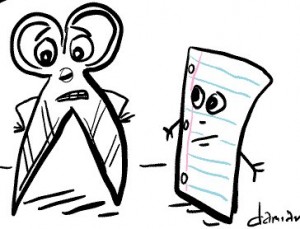A great way to use an e.g. paper to work on organization and transitions!
The Basics:
– Print out several copies of an e.g. paper of your choice and cut it up by paragraph.
– Students organize into groups and each group gets a complete cut-up paper.
– Groups spend about 15 minutes putting the paper back together, making notes as they go explaining their choices. What organizational clues are they finding?
– Discuss the Intro/Conclusion
– What should an Intro do? What kind is this? (Acts Of Inquiry pg. 247)
– What should a Conclusion do? What kind is this? (Acts of Inquiry pg. 265)
– Discuss the order of the main paragraphs. Identify the following:
– Minor claims for the paragraph
– How that claim is developed: what kind of evidence is used?
– Map out a reverse outline on the board, considering relationships between minor claims
If you have more time:
– Groups can work on coming up with alternate organizations and discuss advantages and disadvantages of each
– Students can spend some time outlining an upcoming major paper using new skills
For Instructors:
– Consider using an e.g. paper that resembles one of your major assignments. My students were working on a comparative rhetorical analysis, so I used “Persuasion for a Better Cause” by 2006-2007 winner Ashley Thoreson.
– I’ve found this assignment can be scaffolded in throughout the quarter. Early on, it serves as an introduction to thinking about organization. Later on, it allows you to address surface-level concerns like transition phrases or the known-new clause.
For Students:
– You can modify this activity with your own papers! Find a partner and exchange cut-up drafts. Then, try to put each other’s papers back together. Take a look at where you agree/disagree about organization and discuss:
– What transitional cues are missing in my paper that confused my partner?
– What alternate organizations were suggested by this activity? Would rearranging my argument make it more effective?

